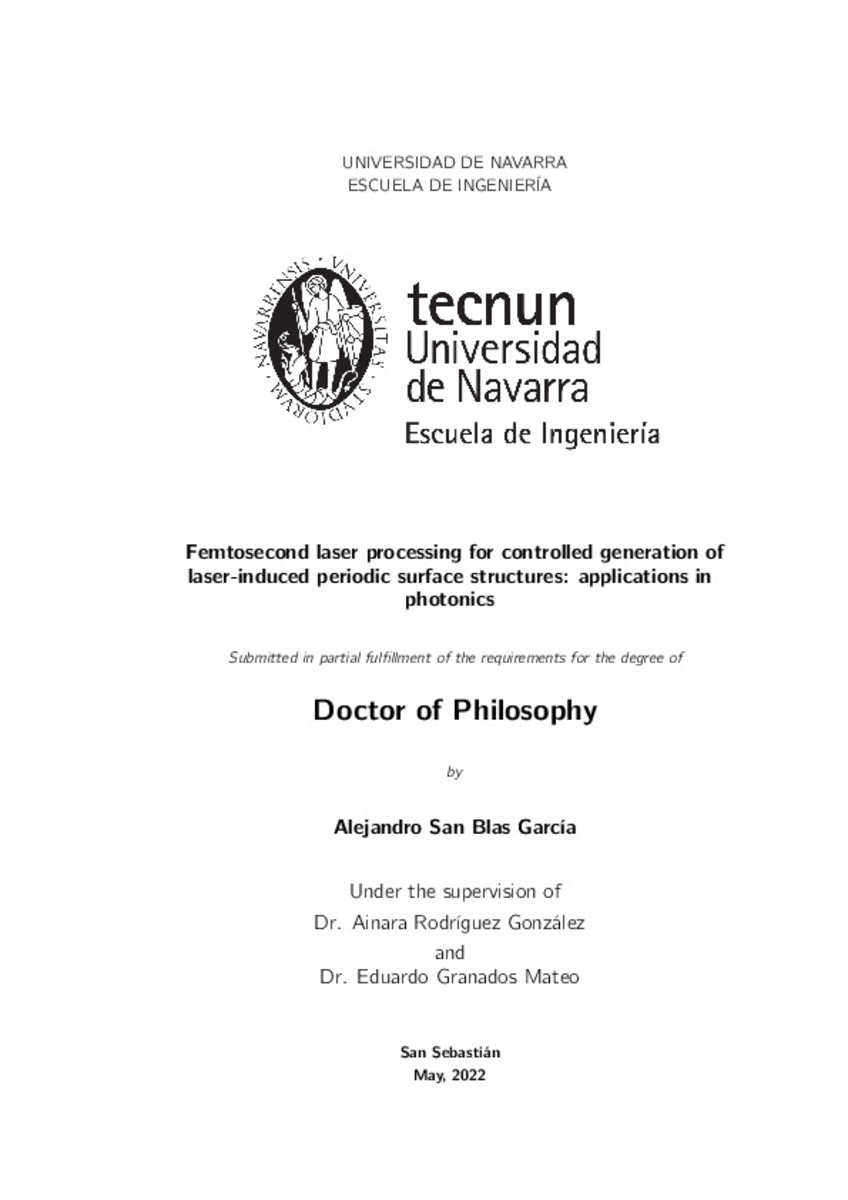Full metadata record
| DC Field | Value | Language |
|---|---|---|
| dc.contributor.advisor | Rodríguez-González, A. (Ainara) | - |
| dc.contributor.advisor | Granados-Mateo, E. (Eduardo) | - |
| dc.creator | San-Blas-García, A. (Alejandro) | - |
| dc.date.accessioned | 2022-10-18T11:22:01Z | - |
| dc.date.available | 2022-10-18T11:22:01Z | - |
| dc.date.issued | 2022-07-18 | - |
| dc.date.submitted | 2022-07-14 | - |
| dc.identifier.citation | SAN BLAS, Alejandro. "Femtosecond laser processing for controlled generation of laser-induced periodic surface structures: applications in photonics." Rodríguez, A. y Granados, E. (dirs.) Tesis doctoral. Universidad de Navarra, Pamplona, 2022 | es_ES |
| dc.identifier.uri | https://hdl.handle.net/10171/64480 | - |
| dc.description.abstract | Femtosecond lasers have transformed the field of material processing by allowing the precise ablation of any type of material with low damage to the surrounding area. Additionally, the generation of structures smaller than the diffraction limit is possible due to the generation of laser-induced periodic surface structures (LIPSS). LIPSS appear in almost any kind of material as a result of the interference between the incident laser light and surface electromagnetic waves (SEWs) induced by the same irradiation, with periods from tens to hundreds of nanometres. As a result, new applications have appeared around surface functionalisation in the micro- and nano-scale. The main limiting factors for the implantation of this cost-efficient and simple technology over others at the industrial level is its low throughput when used for large area processing as well as the low spatial regularity of LIPSS. In this thesis, a processing setup based on cylindrical focusing has been proposed and used for high throughput micro- and nano-structuring, achieving production rates comparable to other commonly used technologies. At the same time, techniques that help improving LIPSS regularity have been demonstrated, such as processing with a plane wavefront, smooth material polishing, or using a large area to avoid lateral overlaps. This technology has been validated through applications related to the field of photonics. The study through numerical simulations of LIPSS processed in the surface of a dielectric showed the potential of their use as anti-reflective properties. The use of LIPSS as reflective waveplates showed that LIPSS may induce a change in the polarisation of an incident beam, while numerical simulations proved that different combinations of the morphology of LIPSS can provide generate greater changes, such as those in half- or quarter-wave plates. This information was used in the fabrication of scales for encoders, combining micro- and nano-structures. The signal detected by the readhead in the encoder was comparable, and even higher in some cases, than that for scales fabricated with lithographic processes. Lastly, gold-coated LIPSS were used in refractometry sensing due to their strong surface plasmon resonances, revealing sensitivity values comparable to sensors fabricated with other cost-efficient techniques. The results extracted in this thesis show that femtosecond laser processing is a environmentally friendly and low cost alternative that can compete with other technologies in the fabrication of micro- and nano-structures in industrial and scientific applications. | es_ES |
| dc.language.iso | eng | es_ES |
| dc.rights | info:eu-repo/semantics/openAccess | es_ES |
| dc.subject | Laser | es_ES |
| dc.subject | Femtosecond | es_ES |
| dc.subject | LIPSS | es_ES |
| dc.subject | Photonics | es_ES |
| dc.subject | Plasmonics | es_ES |
| dc.subject | Encoders | es_ES |
| dc.title | Femtosecond laser processing for controlled generation of laser-induced periodic surface structures: applications in photonics. | es_ES |
| dc.type | info:eu-repo/semantics/doctoralThesis | es_ES |
| dc.identifier.doi | 10.15581/10171/64480 | - |
Files in This Item:
Statistics and impact
Items in Dadun are protected by copyright, with all rights reserved, unless otherwise indicated.






